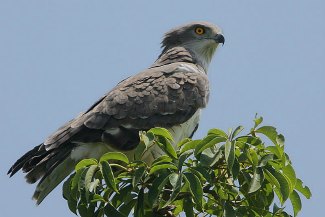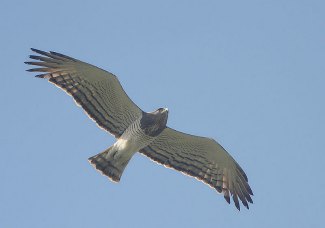Beaudouin's Snake Eagle
By Steve Garvie, CC-BY-NC-SA-2.0, via Wikimedia Commons/ Flickr
Family: Accipitridae
Genus: Circaetus
Species: C. beaudouini
Beaudouin's Snake Eagles are medium-sized to large eagles that occur in grassland and savannah across a narrow range in sub-Saharan Africa. They form a superspecies with Circaetus gallicus (Short-Toed Snake Eagle) and Circaetus pectoralis (Black-Chested Snake Eagle).
Physical Description:
Beaudouin’s Snake Eagles have a white barred belly and a dark gray-brown back and wings. The underwing is white with black bars and the primary feathers have black tips. The legs and cere are gray, and the eyes are bright yellow. They closely resemble Circaetus gallicus (Short-Toed Snake Eagle), which lives in their range during the winter, but Beaudouin's Snake Eagles are smaller and have shorter wings.
Juveniles are completely brown, except for some white streaking on head and barring on the flanks.
Size:
Length: 60-66 cm
Wingspan: 155-170 cm
Habitat and Distribution:
Beaudouin’s Snake Eagles live in dry savannah, open grassland, and some cultivated areas, from 16°N to 2°N. They are most common below 1,000 meters above sea level, but have been found as high as 2,000 m.
They occupy a region of Africa that spans Senegal, Gambia, Maritania, Sudan, Guinea, Côte d'Ivoire, Burkina Faso, Nigeria, Cameroon, and the Central African Republic. This area also includes the Sahel, the border between the Sahara Desert and more tropical areas to the south. Some are nomadic or migrate with the seasons, some may wander, and some birds remain sedentary. There are an estimated 2,500-9,999 individuals, and their population is not thought to be more than 10,000.
By Steve Garvie, CC-BY-NC-SA-2.0, via Wikimedia Commons/ Flickr
Diet and Hunting:
Beaudouin's Snake Eagles eat snakes, lizards, birds, insects, and some small mammals such as rodents. They hunt from a perch or from the air, occasionally hovering.
Reproduction:
The breeding season is from November-March in western Africa, but it may be longer further east along the equator.
The nest is small and made out of sticks and usually 25 or more meters above the ground. A single egg is laid and incubated for an estimated 45 days. Fledging takes 70 days.
Conservation:
Beaudouin’s Snake Eagles have been listed as Vulnerable BirdLife International due to their small, rapidly declining population. Over the past 30-35 years the number of recorded Beaudouin’s Snake Eagles in Senegal and Niger has decreased by 80-93%, which is equal to a decline of 30-50% over ten years/three generations. Agriculture, human development, overgrazing, woodcutting, hunting, and urbanization are all threats to the bird, and in particular the spraying of organochlorine insecticides onto cotton fields. The insects killed by the organochlorine are a source of food for the prey of the raptors and are eaten directly by the raptors as well.
Taxonomy:
Circaetus beaudouini was previously considered to be a subspecies of Circaetus gallicus (Short-Toed Snake Eagle) (along with Circaetus pectoralis (Black-Chested Snake Eagle) and Circaetus fasciolatus (Southern Banded Snake Eagle)) but all three former subspecies are now thought to be distinct, and C. beaudouini, C. gallicus, and C. pectoralis form a superspecies.
Other Names:
Beaudouin’s Harrier Eagle, Orlík savanový (Czech), Sahelsangeørn (Danish), Saheli madukotkas (Estonian), Sahelinkäärmekotka (Finnish), Circaète de Beaudouin (French), Beaudouin Schlangenadler (German), Biancone di Beaudouin (Italian), Guineaslangeørn (Norwegian), Gadozer prazkowany (Polish), Culebrera Sudanesa (Spanish), Beaudouins ormörn (Swedish).
Other Multimedia:
None available.
References:
http://www.arkive.org/beaudouins-snake-eagle/circaetus-beaudouini/
http://avibase.bsc-eoc.org/species.jsp?avibaseid=F4E78AFABD80B6AD
BirdLife International (2011) Species factsheet: Circaetus beaudouini. Downloaded from
http://www.birdlife.org on 29/07/2011
http://ibc.lynxeds.com/species/beaudouins-snake-eagle-circaetus-beaudouini
BirdLife International 2008. Circaetus beaudouini. In: IUCN 2011. IUCN Red List of Threatened Species. Version 2011.1.
www.iucnredlist.org. Downloaded on 29 July 2011.
http://maps.unomaha.edu/peterson/funda/notes/notes_exam4/sahel.html
Ferguson-Lees, James, and Christie, David A. Raptors of the World. Houghton Mifflin Company, 2001.
http://worldbirds.eu/abcb/beaudouins_snake_eagle.htm

